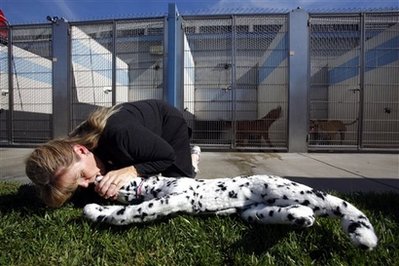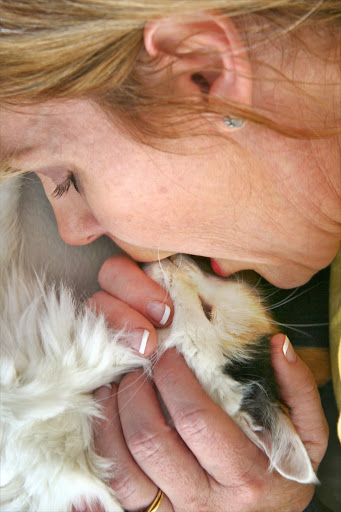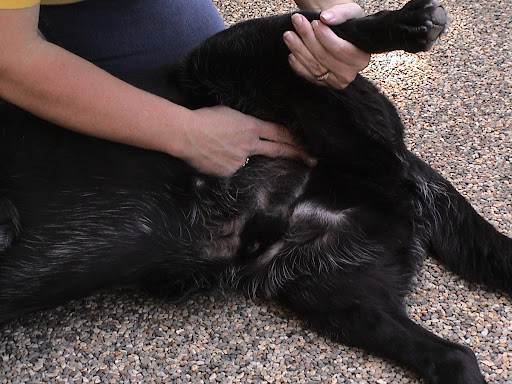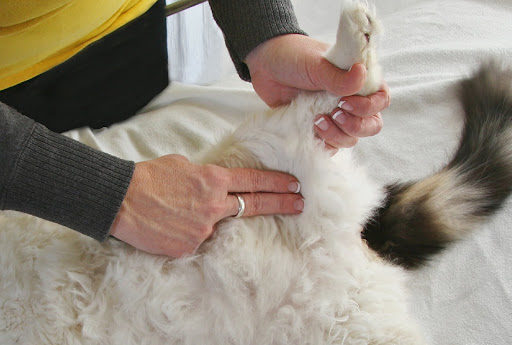Animal CPR (a big LOL)
**********************************************************
CPR in dog
CPR is an emergency technique used to help someone whose heart and/or breathing has stopped. Although somewhat modified, the same techniques used for people – rescue breathing and chest compression – can be used to help treat an animal in distress.
The first lesson to know about CPR is that it doesn't restart a stopped heart. The purpose of CPR, in both humans and animals, is to keep them alive until the heart begins beating on its own or a cardiac defibrillator can be used. In animals, CPR is frequently unsuccessful, even if performed by a trained veterinarian. Even so, attempting CPR will give animal fighting chance.

PCR on cat
At first, we must know the ABC rules!
A-Airway
2.Carefully pull the tongue straight out of the animal’s mouth to open the airway
3. Make sure that the neck is reasonably straight; try to bring the head in-line withthe neck.
WARNING: Do not over-straighten the neck in cases where neck/head trauma exists
4. Attempt 2 rescue breaths, by closing the mouth, and performing mouth-to-nose ventilations. If they go in with no problems continue to B-Breathing.

Opening airway in dog

Opening airway in cat
6.Visibly inspect the airway by looking into the mouth, and down the throat for foreign objects occluding the airway. Unlike human-CPR, rescuers may reach into the airway and remove foreign objects that are visible.
Heimlich maneuver
Use to remove choking material that cause inability in breathing
1. Turn the animal upside down, with its back against your chest 2. Hug the animal with your fist in your hand, just below the rib-cage ( for cats, just squeeze 1 hand in the same place)
2. With both arms, give 5 sharp thrusts (bear hugs) to the abdomen. Perform each thrust as if it is the one that will expel the object
3. Stop, check to see if the object is visible in the airway, if so, remove it and give 2 mouth-nose rescue breaths. If the breaths do not go in, go back to step 1
Heimlich maneuver
B-Breathing
After achieving a patent airway, one must determine whether the animal is breathing, and whether this breathing is effective:
2. Make sure that the neck is reasonably straight; try to bring the head in-line withthe neck.
3. Breathe at 12 breaths per minute (1 every 5 seconds)With each breath just make the chest rise (do not overinflate, expecially on a small animal)
IMPORTANT: If the breaths do not go in, stop and return to A-Airway!
Proceed to C-Circulation, while continuing breathing support as necessary.
Check the femoral pulse!

Dog

Cat
C- Circulation
This is the final step of CPR and should only be started after the A-airway and B-breathing steps have been completed:
1. Make sure that there are no major (pooling/spurting blood) points of bleeding. Control as necessary by applying pressure with your hand
2. Check for a pulse in the groin (check carefully on a conscious dog or cat!)
3. Lay the animal on its right side

4. Locate your hands where its left elbow touches the chest, approximately the middle of the rib-cage (for cats use 1 hand in asqueezing motion).

Location of heart
Compress the chest 15 times followed by 2 rescue breaths (3 compression every 2 seconds). Deliver 2 more breath. Repeat. Every 4 cycle for a pulse.

Compression for small cats and dogs: Use fingertips to compress heart in place of your left hand or place 4 fingers of your left hand under the animal’s chest and compress on the top with left thumb: 5 compression/1 breath and check for a pulse every 8-10 cycles.
If there are two people, one breathes and the others compresses at the rate of one breath for every 2-3 compression
After the CPR is successfully performed, quickly send the animal to the nearest vet!
Precaution in CPR
2. Never breathe or compress on an animal that is breathing or has a pulse.
3. When doing compression, realize you must compress 1/4 to 1/3 the width of the chest. You must flex the ribs, press the lungs in order to squeeze the blood out of the heart and release so that it can flow around and back into the other chamber.
4. For barrel-chested breeds, you may position dog on his back and compress chest human-style (hand on top of hand over chest): 15 compressions/2 breaths checking for a pulse every 4 cycles.

Barrel-chested dog
**Perform CPR until you have reached a veterinary hospital. After 20 minutes, however, the chances of reviving an animal are extremely unlikely.
Sources: Sheraton luxuries; CPR guide, CPR in dogs;petplace.com, dailywag; Martha steward.com; Pet first aid




















6 comments:
Quite superb post and method for CPR for Dog, everyone can learning and save his pet.
very useful post. We have CPR Manikin for sale in malaysia. Contact IBSMEDIC for more details.
The LVR rescue training class element of the training covers the knowledge and skills needed for a individual to have the ability to perform a hazard assessment of an electrically hazardous circumstance and perform low voltage rescue processes without risk to themselves or other people.
Thanks for sharing this wonderful information.
PALS Online Rancho Mirage CA
Nice Article. First Aid Course is really important to everyone. It can save life and it also promote recovery. If you want to learn more about cardiopulmonary resuscitation. See More
Great information. Thank you for sharing
Download Indian Doctors Networkwhere you can network and communicate with executive committee members, senior doctors and mentors.
Post a Comment